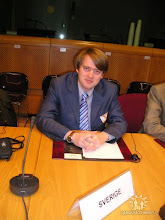President of the PIR Center Vladimir Orlov gave a presentation to the graduate students of the Georgetown University (Washington, DC) on the US-Russia relations and the prospects for strategic offensive arms reductions by both sides in the light of the decisions agreed to in London by Presidents Dmitry Medvedev and Barak Obama on April 1, 2009.
In his presentation President of the PIR Center directed student's attention to a noticeable warming-up in the US-Russian relations during the recent weeks that stands in sharp contrast with “cold peace,” which reigned in the bilateral relations in the recent years and became evident in August 2008 as a result of the US support for Georgia in the Southern Caucasus conflict. “It is important to convert this to a large extent emotional warming-up into a sustainable long-term one,” Vladimir Orlov stated.
Vladimir Orlov noted that a “collective face” of the US administration has qualitatively changed. Highly professional people have taken the key positions in the Obama's team, especially those related to WMD nonproliferation and nuclear arms control. “It per se will not eliminate all disagreements existing between our two countries. It, however, considerably strengthens the climate of trust, removes unnecessary suspicion and permits to concentrate on actual work and reaching common objectives. High professionalism of many members of Obama's team also enables to lift the level of the intellectual dialogue. And to tell the truth, we in Moscow have been missing this greatly. The bar has been lifted high and Moscow will also have to do some homework to match the qualitatively new level of dialogue,” Vladimir Orlov emphasized.
Answering the questions of the students, President of the PIR Center expressed his optimism that it was real to achieve the set goal, i.e. to conclude a new treaty on strategic arms reductions and sign it till the end of 2009. This treaty would reduce strategic arms to about 1,500 warheads on each side. “But if we talk about more radical reductions, then it is the next step. To have an agreement on radical reductions of strategic arms the negotiators from both countries even with the presence of political will and good faith will need not months, but years of meticulous work.”
These new agreements when the levels of the nuclear armaments would be limited to 1,000 warheads or even less will have to be accompanied by a serious dialogue on the interrelation of offensive and defensive armaments, including the change of the ballistic missile defense deployment plans in Europe to joint decisions on preventing missile threats; strategic weapons with conventional (non-nuclear) warheads; non-deployment of nuclear weapons on foreign soil; destabilizing effects of the deployment of weapons in space; nonstrategic nuclear weapons.
“When contemplating a way to radical reductions in nuclear arsenals both the United States and Russia should make sure to decrease the role of nuclear weapons in their defense doctrines and national security concepts,” President of the PIR Center Vladimir Orlov underlined.
For more details on the presentations of the PIR Center President Vladimir Orlov, please, visit his blog on international security.
For more comments from PIR Center's experts, please, call +7 (495) 987-19-15.
Subscribe to:
Post Comments (Atom)

No comments:
Post a Comment